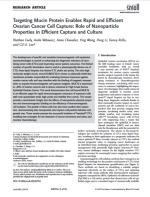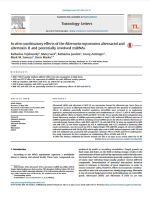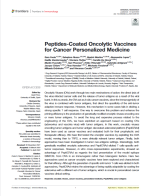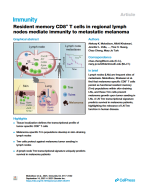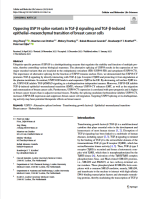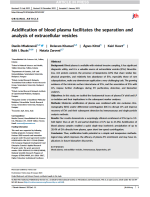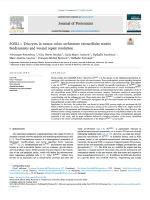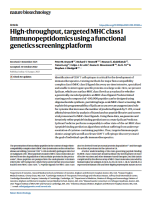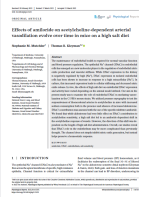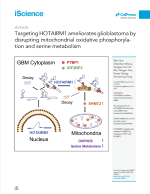31.03.2023
Targeting Mucin Protein Enables Rapid and Efficient Ovarian Cancer Cel... Small, 2023
Abstract The development of specific and sensitive immunomagnetic cell separation nanotechnologies is central to enhancing the diagnostic relevance of circulating tumor cells (CTCs) and improving cancer patient outcomes. The limited number of specific biomarkers used to enrich a phenotypically diverse set of CTCs from liquid biopsies has limited CTC yields and purity. The ultra-high molecular weight mucin, mucin16 (MUC16) is shown to physically shield key membrane proteins responsible for activating immune responses a...
24.03.2023
In vitro combinatory effects of the Alternaria mycotoxins alternariol... Toxicology Letters, 2017
Abstract Alternariol (AOH) and altertoxin II (ATX II) are mycotoxins formed by Alternaria spp. Since they are expected to co-occur in Alternaria-infested food and feed, we addressed the question of combinatory effects. In addition, potentially involved regulatory microRNAs were surveyed in an exploratory approach. Cytotoxicity measurements in constant ratio combinations of 1:10 or 1:1 (ATX II: AOH) mainly revealed additive effects in HepG2, HT29 and HCEC-1CT cells. Yet, in specific high doses antagonism was found. Microar...
17.03.2023
Peptides-Coated Oncolytic Vaccines for Cancer Personalized Medicine Frontiers in Immunology, 2022
Abstract Oncolytic Viruses (OVs) work through two main mechanisms of action: the direct lysis of the virus-infected cancer cells and the release of tumor antigens as a result of the viral burst. In this scenario, the OVs act as cancer vaccines, since the immunogenicity of the virus is combined with tumor antigens, that direct the specificity of the anti-tumor adaptive immune response. However, this mechanism in some cases fails in eliciting a strong specific T cell response. One way to overcome this problem and enhance the priming efficiency...
03.03.2023
Resident memory CD8+ T cells in regional lymphnodes mediate immunity t... Immunity, 2021
Abstract The nature of the anti-tumor immune response changes as primary tumors progress and metastasize. We investigated the role of resident memory (Trm) and circulating memory (Tcirm) cells in anti-tumor responses at metastatic locations using a mouse model of melanoma-associated vitiligo. We found that the transcrip- tional characteristics of tumor-specific CD8 +
24.02.2023
Opposing USP19 splice variants in TGF-β signaling and TGF-β-induced ep... Cellular and Molecular Life Sciences, 2023
Abstract Ubiquitin-specific protease (USP)19 is a deubiquitinating enzyme that regulates the stability and function of multiple proteins, thereby controlling various biological responses. The alternative splicing of USP19 results in the expression of two major encoded variants that are localized to the endoplasmic reticulum (ER) (USP19-ER) and cytoplasm (USP19-CY). The importance of alternative splicing for the function of USP19 remains unclear. Here, we demonstrated that USP19-CY promotes TGF-β signaling by directly interacting with...
17.02.2023
Acidification of blood plasma facilitates the separation and analysis... ScienceDirect, 2023
Abstract Background Blood plasma is available with minimal invasive sampling, it has significant diagnostic utility, and it is a valuable source of extracellular vesicles (EVs). Nevertheless, rich protein content, the presence of lipoproteins (LPs) that share similar biophysical properties, and relatively low abundance of EVs, especially those of rare subpopulations, make any downstream application a very challenging task. The growing evidence of the intricate surface interactome of EVs, and the association of EVs with LPs, impos...
10.02.2023
FOXL1+ Telocytes in mouse colon orchestrate extracellular matrix biody... Proteomics, 2023
Abstract Recent studies have identified FoxL1+-telocytes (TCFoxL1+) as key players in gut epithelial-mesenchymal interactions which can determine the colonic microenvironment. Bone morphogenetic protein signaling disruption in TCFoxL1+ alters the physical and cellular microenvironment and leads to colon pathophysiology. This suggests a role for TCFoxL1+ in stromagenesis, but it is hard to identify the specific contribution of TCFoxL1+ when analyzing whole tissue profiling studies. We performed ex vivo deconstruction of control and BmpR1a△F...
27.01.2023
High-throughput, targeted MHC class I immunopeptidomics using a functi... Nature Biotechnology, 2023
Abstract Identification of CD8+ T cell epitopes is critical for the development of immunotherapeutics. Existing methods for major histocompatibility complex class I (MHC class I) ligand discovery are time intensive, specialized and unable to interrogate specific proteins on a large scale. Here, we present EpiScan, which uses surface MHC class I levels as a readout for whether a genetically encoded peptide is an MHC class I ligand. Predetermined starting pools composed of >100,000 peptides can be designed using oligonucleotide synthesis,...
20.01.2023
Effects of amiloride on acetylcholine-dependent arterial vasodilation... Physiological Reports, 2022
Abstract The maintenance of endothelial health is required for normal vascular function and blood pressure regulation. The epithelial Na+ channel (ENaC) in endothelial cells has emerged as a new molecular player in the regulation of endothelial nitric oxide production and vascular stiffness. While ENaC expression in the kidney is negatively regulated by high [Na+ ], ENaC expression in isolated endothelial cells has been shown to increase in response to a high extracellular [Na+ ]. In culture, this increased expression leads to cellular sti...
13.01.2023
Targeting HOTAIRM1 ameliorates glioblastoma by disrupting mitochondria... Cell Press, 2022
Abstract Serine hydroxymethyltransferase 2 (SHMT2), which catalyzes the conversion of serine to glycine and one-carbon transfer reactions in mitochondria, is significantly upregulated in glioblastoma (GBM). However, the mechanism by which the stability of SHMT2 gene expression is maintained to drive GBM tumorigenesis has not been clarified. Herein, through microarray screening, we identified that HOXA Transcript Antisense RNA, Myeloid-Specific 1 (HOTAIRM1) modulates the SHMT2 level in various GBM cell lines. Serine catabolism and...



